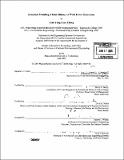| dc.contributor.advisor | Henry D. Jacoby. | en_US |
| dc.contributor.author | Cheng, Alan Yung Chen | en_US |
| dc.contributor.other | Massachusetts Institute of Technology. Dept. of Civil and Environmental Engineering. | en_US |
| dc.date.accessioned | 2006-03-29T18:30:38Z | |
| dc.date.available | 2006-03-29T18:30:38Z | |
| dc.date.copyright | 2005 | en_US |
| dc.date.issued | 2005 | en_US |
| dc.identifier.uri | http://hdl.handle.net/1721.1/32284 | |
| dc.description | Thesis (S.M.)--Massachusetts Institute of Technology, Engineering Systems Division, Technology and Policy Program; and, (S.M.)--Massachusetts Institute of Technology, Dept. of Civil and Environmental Engineering, 2005. | en_US |
| dc.description | Includes bibliographical references (p. 59-61). | en_US |
| dc.description.abstract | The electricity sector is a major source of carbon dioxide emissions that contribute to global climate change. Over the past decade wind energy has steadily emerged as a potential source for large-scale, low carbon energy. As wind power generation increases around the world, there is increasing interest in the impacts of adding intermittent power to the electricity grid and the potential costs of compensating for the intermittency. The goal of this thesis research is to assess the costs and potential of wind power as a greenhouse gas abatement option for electricity generation. Qualitative and quantitative analysis methods are used to evaluate the challenges involved in integrating intermittent generation into the electricity sector. A computable generation equilibrium model was developed to explicitly account for the impacts of increasing wind penetration on the capacity value given to wind. The model also accounts for the impacts of wind quality and geographic diversity on electricity generation, and the impacts of learning-by-doing on the total cost of production. We notice that the rising costs associated of intermittency will limit the ability of wind to take a large share of the electricity market. As wind penetration increases, a greater cost is imposed on the wind generator in order to compensate for the intermittency impacts, making the total cost from energy from wind more expensive. Because the model explicitly accounts for the impacts of intermittency, the decision to add wind power to the grid is based on the marginal cost of adding additional intermittent sources to the system in addition to the cost of generating wind energy. | en_US |
| dc.description.abstract | (cont.) This model was incorporated into the MIT Emissions Prediction and Policy Analysis model in order to analyze the adoption of wind technology under three policy scenarios. In a business as usual scenario with no wind subsidies or carbon constraints, wind energy generation rises to 0.80 trillion KWh in 2090 and accounts for 9% of the total electricity generation. In a scenario that stabilized greenhouse gases at 550 parts per million, high carbon penalties motivate the entry of 1.16 trillion KWh of wind energy generation in 2055 that accounts for 22% of the total electricity generation. With a production tax credit subsidy for wind generation, wind energy generation increases by average of 12% over the base case scenario during the years the policy was in effect. However, when the subsidy tapers off, wind generation in later periods remains unchanged. | en_US |
| dc.description.statementofresponsibility | by Alan Yung Chen Cheng. | en_US |
| dc.format.extent | 61 p. | en_US |
| dc.format.extent | 4152971 bytes | |
| dc.format.extent | 4153221 bytes | |
| dc.format.mimetype | application/pdf | |
| dc.format.mimetype | application/pdf | |
| dc.language.iso | eng | en_US |
| dc.publisher | Massachusetts Institute of Technology | en_US |
| dc.rights | M.I.T. theses are protected by copyright. They may be viewed from this source for any purpose, but reproduction or distribution in any format is prohibited without written permission. See provided URL for inquiries about permission. | en_US |
| dc.rights.uri | http://dspace.mit.edu/handle/1721.1/7582 | |
| dc.subject | Technology and Policy Program. | en_US |
| dc.subject | Civil and Environmental Engineering. | en_US |
| dc.title | Economic modeling of intermittency in wind power generation | en_US |
| dc.type | Thesis | en_US |
| dc.description.degree | S.M. | en_US |
| dc.contributor.department | Massachusetts Institute of Technology. Department of Civil and Environmental Engineering | |
| dc.contributor.department | Massachusetts Institute of Technology. Engineering Systems Division | |
| dc.contributor.department | Technology and Policy Program | |
| dc.identifier.oclc | 61325808 | en_US |
